教学课件 --冀教版中学英语七年级(下) UNIT2 Lesson12
文档属性
| 名称 | 教学课件 --冀教版中学英语七年级(下) UNIT2 Lesson12 | 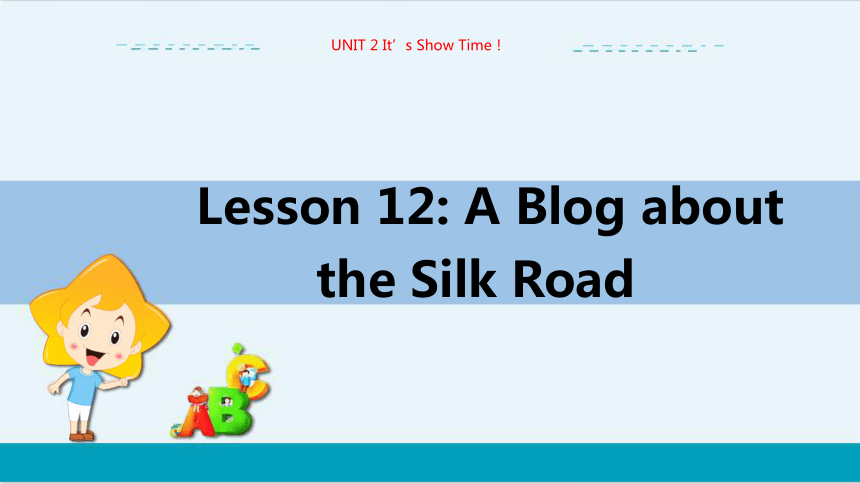 | |
| 格式 | pptx | ||
| 文件大小 | 3.7MB | ||
| 资源类型 | 试卷 | ||
| 版本资源 | 冀教版 | ||
| 科目 | 英语 | ||
| 更新时间 | 2024-02-21 19:48:13 | ||
图片预览

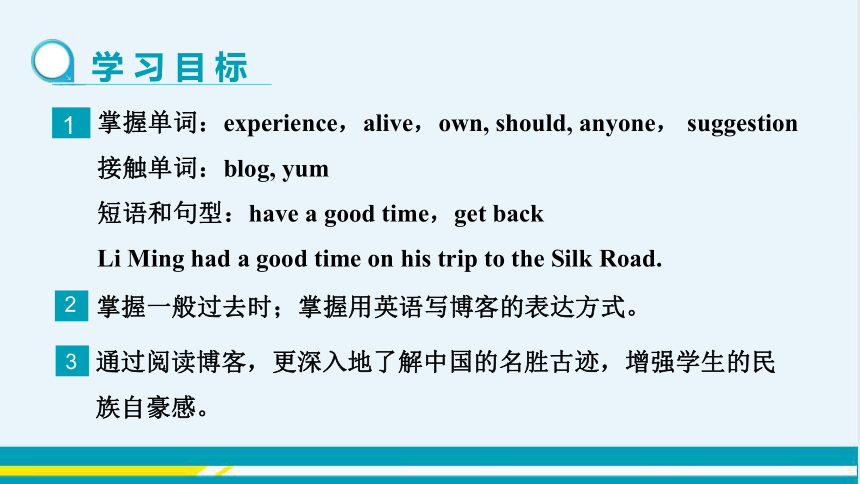


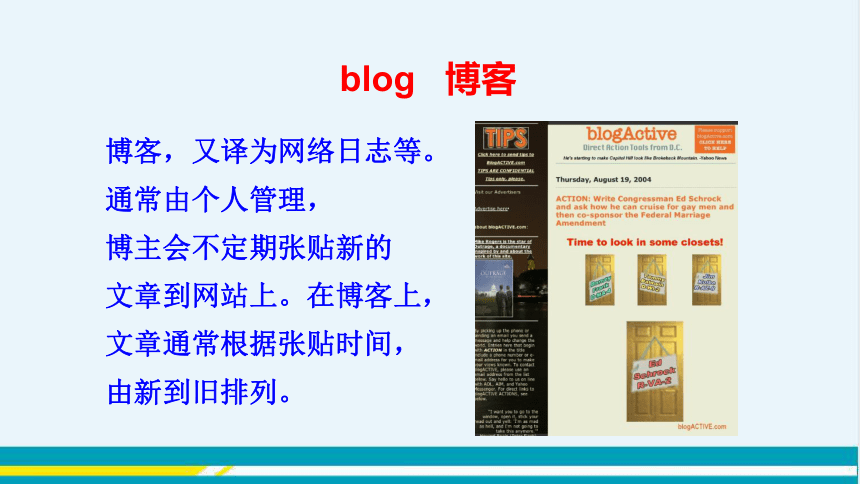
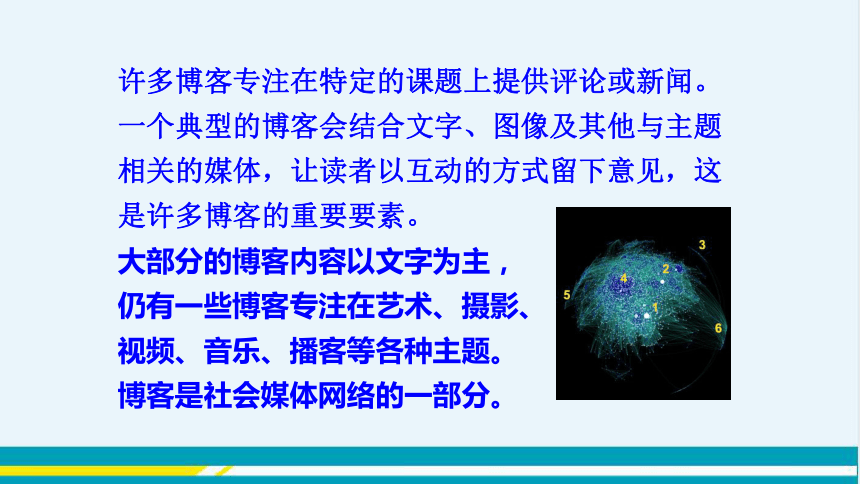
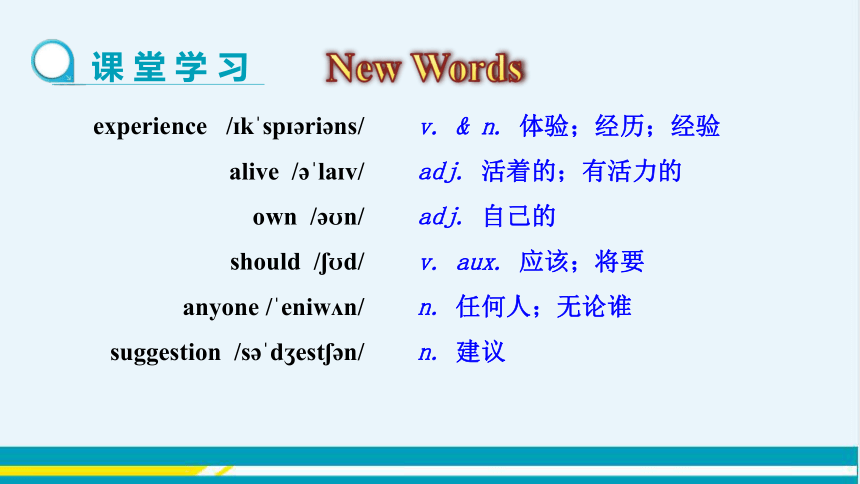
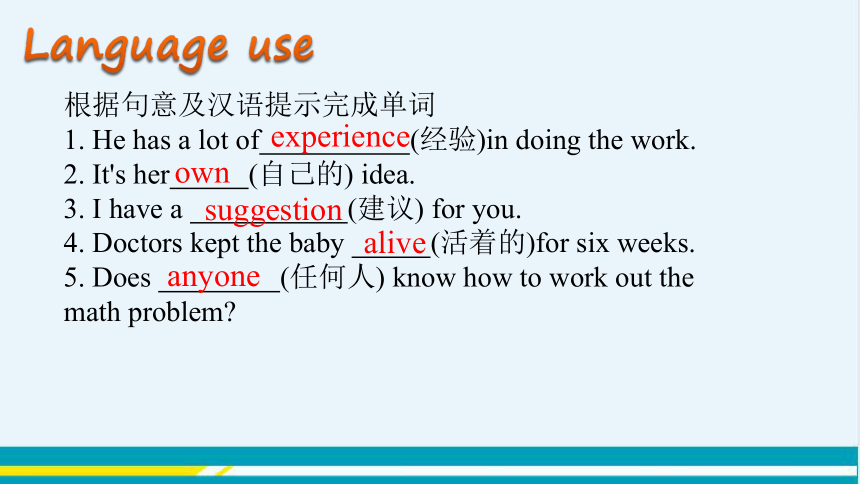
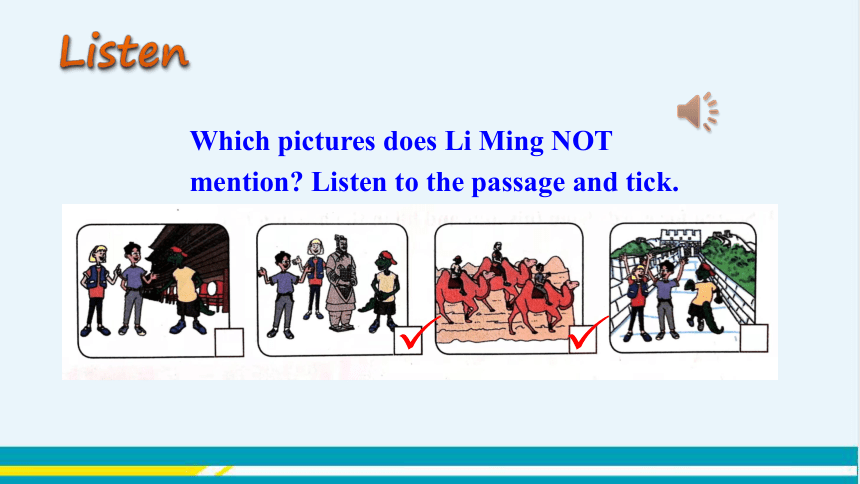
文档简介
(共24张PPT)
Lesson 12: A Blog about the Silk Road
UNIT 2 It’s Show Time!
学 习 目 标
掌握单词:experience,alive,own, should, anyone, suggestion接触单词:blog, yum
短语和句型:have a good time,get back
Li Ming had a good time on his trip to the Silk Road.
1
3
通过阅读博客,更深入地了解中国的名胜古迹,增强学生的民族自豪感。
掌握一般过去时;掌握用英语写博客的表达方式。
2
Do you know what is a blog
Do you have a blog
What do you usually do on the blog
Lead in
课 堂 导 入
You can write anything you like in your blog. For example, you can write about your trip, show some photos, and share some stories and food.
博客,又译为网络日志等。
通常由个人管理,
博主会不定期张贴新的
文章到网站上。在博客上,
文章通常根据张贴时间,
由新到旧排列。
blog 博客
许多博客专注在特定的课题上提供评论或新闻。一个典型的博客会结合文字、图像及其他与主题相关的媒体,让读者以互动的方式留下意见,这是许多博客的重要要素。
大部分的博客内容以文字为主,
仍有一些博客专注在艺术、摄影、
视频、音乐、播客等各种主题。
博客是社会媒体网络的一部分。
experience / k sp ri ns/
alive / la v/
own / n/
should / d/
anyone / eniw n/
suggestion /s d est n/
v. & n. 体验;经历;经验
adj. 活着的;有活力的
adj. 自己的
v. aux. 应该;将要
n. 任何人;无论谁
n. 建议
New Words
课 堂 学 习
根据句意及汉语提示完成单词
1. He has a lot of (经验)in doing the work.
2. It's her (自己的) idea.
3. I have a (建议) for you.
4. Doctors kept the baby (活着的)for six weeks.
5. Does (任何人) know how to work out the math problem
Language use
experience
own
suggestion
alive
anyone
Which pictures does Li Ming NOT mention Listen to the passage and tick.
Listen
Listen and read
Listen to the lesson and read by yourselves.
Li Ming had a good time on his trip to the Silk Road.
He saw and ______________ many great things. On
the trip, he learned China has a _______ history and
a _______ culture. The history of China is ______ in
the ancient city of Xi’an. He ________to travel more
around his country someday.
experienced
long
rich
alive
hoped
Read the lesson and fill in the blanks.
Retell
Retell the lesson.
Wang Mei is searching for more information about the Silk Road. Work in groups. Help her answer the questions below.
1. When did people begin to travel along the Silk Road
2. What other cities or districts does the Silk Road go through
People began to travel along the Silk Road
2,000 years ago.
It goes through Xi’an, Lanzhou and Xinjiang Uygur Autonomous Region.
Work in groups
3. How did it get the name the “Silk Road”?
It got the name because people moved silk and other goods between Asia and Europe. Among all the goods, silk was the most expensive and special thing.
Write an e-mail to a friend about a trip you went on. Show him or her some pictures from your trip.
Task tips:
Where / When did you go
Who did you go with
What did you see and experience
Did you eat any traditional or special foods
Write
1. We learned some new words and phrases.
2. We learned about Li Ming's trip to the Silk Road.
Sum up
Li Ming had a good time on his trip to the Silk Road.
李明在他去丝绸之路的旅行中玩得非常开心。
(1) have a good time 玩得开心,过得愉快。相当于enjoy oneself/have fun。
例:Look!The children are having a good time over there. 看!孩子们正在那边玩得很开心。
(2) on one's trip to在某人去……的旅途中。其中 to是介词,to后要跟地点名词。
例:My brother is on his trip to Xiamen.
我哥哥正在去厦门的旅途中。
Language points
2. The history of China is so alive in these places. 这些地方中国的历史是如此有活力。
【辨析】alive、lively、living 与 live
(1) alive 意为“活着的”,侧重说明生与死的区别。
既可指人,也可指物;可作表语、后置定语或宾补。
例:She does not know if he is alive or dead. 她不知道他是生是死。
(2) lively 意为“活泼的,活跃的,充满生气的”,
既可指人,又可指物。可作定语、表语或宾补。
例:Josephine was a bright, lively and cheerful girl.
约瑟芬是一个开朗、活泼又欢乐的女孩。
(3) living 意为“活着的”,强调 “尚在人间,健在”,
可用来指人或物,作定语或表语。注意:the living 指“活着的人们”。 常用短语:make a living 谋生
例:She is like a living doll. 她就像一个活着的玩偶。
(4) live 意为“活着的”,通常指物,不指人,常放在名词的前面作定语。它还可意为“实况转播的”。
例:The cat was playing with a live mouse.那只猫在玩弄一只活老鼠。
3. I saw my own history and culture in a new way.
我用一种新的方式来看待自己的历史和文化。
(1) own作形容词,意为“自己的”。常用在形容词性物主代词或名词所有格之后。
例:She is old enough to wash her own clothes.
她足够大了,能够自己洗衣服了。
(2) in a way 意为“用一种方法”,此处的 in 表示“以/用…… (工具、材料、方法、手段)”。
例:I made this cake in a different way.
我用了一种不同的方法制作这种蛋糕。
4. Where should I go next?下一次我该去那里呢?
should 是情态动词,意为“应该”。情态动词不能单独在句子中作谓语,必须接动词原形后一起构成谓语部分。should的否定式为should not,缩写为shouldn't。它没有人称和数的变化,即用在所有人称后面都用原形。当含有should的陈述句变为疑问句时,要将should放在主语的前面。
例:You should follow his suggestion. 你应该接受他的建议。→ Should I follow his suggestion?我应该接受他的建议吗?
5. Does anyone have any suggestions?有人能给出一些建议吗?
(1)anyone 是复合不定代词,在本句中意为“一些人,无论谁”,常用在否定句和疑问句中。anyone 在肯定句中表示“任何人”。其同义词为anybody;当anyone 作主语时,谓语动词用单数形式。
例:Does anyone want to have a try?有人想试试吗?
Anyone can have a try. 任何人都可以尝试。
(2) suggestion 作可数名词,意为“建议”。常用搭配:make a suggestion 提出建议。
例: John, can I make a suggestion 约翰,我可以提个建议吗?
用所给词的适当形式填空
1. This ______ (be) me with a funny dog.
2. No one has any new ____________ (suggestion)
about the New Year's party of my class.
3. I show some ______ (photo) to my classmates.
4. You should ______ (see) your grandparents once a week.
5. Look! Danny __________ (ride) a camel in the picture.
suggestions
is
see
photos
is riding
课 堂 达 标
1. Review and recite the imporant language
points of Lesson 12.
2. Write an e-mail to a friend about one of your trips, including some photos from your trip.
3. Preview Unit 3 Lesson 13.
Homework
Thank you !
Lesson 12: A Blog about the Silk Road
UNIT 2 It’s Show Time!
学 习 目 标
掌握单词:experience,alive,own, should, anyone, suggestion接触单词:blog, yum
短语和句型:have a good time,get back
Li Ming had a good time on his trip to the Silk Road.
1
3
通过阅读博客,更深入地了解中国的名胜古迹,增强学生的民族自豪感。
掌握一般过去时;掌握用英语写博客的表达方式。
2
Do you know what is a blog
Do you have a blog
What do you usually do on the blog
Lead in
课 堂 导 入
You can write anything you like in your blog. For example, you can write about your trip, show some photos, and share some stories and food.
博客,又译为网络日志等。
通常由个人管理,
博主会不定期张贴新的
文章到网站上。在博客上,
文章通常根据张贴时间,
由新到旧排列。
blog 博客
许多博客专注在特定的课题上提供评论或新闻。一个典型的博客会结合文字、图像及其他与主题相关的媒体,让读者以互动的方式留下意见,这是许多博客的重要要素。
大部分的博客内容以文字为主,
仍有一些博客专注在艺术、摄影、
视频、音乐、播客等各种主题。
博客是社会媒体网络的一部分。
experience / k sp ri ns/
alive / la v/
own / n/
should / d/
anyone / eniw n/
suggestion /s d est n/
v. & n. 体验;经历;经验
adj. 活着的;有活力的
adj. 自己的
v. aux. 应该;将要
n. 任何人;无论谁
n. 建议
New Words
课 堂 学 习
根据句意及汉语提示完成单词
1. He has a lot of (经验)in doing the work.
2. It's her (自己的) idea.
3. I have a (建议) for you.
4. Doctors kept the baby (活着的)for six weeks.
5. Does (任何人) know how to work out the math problem
Language use
experience
own
suggestion
alive
anyone
Which pictures does Li Ming NOT mention Listen to the passage and tick.
Listen
Listen and read
Listen to the lesson and read by yourselves.
Li Ming had a good time on his trip to the Silk Road.
He saw and ______________ many great things. On
the trip, he learned China has a _______ history and
a _______ culture. The history of China is ______ in
the ancient city of Xi’an. He ________to travel more
around his country someday.
experienced
long
rich
alive
hoped
Read the lesson and fill in the blanks.
Retell
Retell the lesson.
Wang Mei is searching for more information about the Silk Road. Work in groups. Help her answer the questions below.
1. When did people begin to travel along the Silk Road
2. What other cities or districts does the Silk Road go through
People began to travel along the Silk Road
2,000 years ago.
It goes through Xi’an, Lanzhou and Xinjiang Uygur Autonomous Region.
Work in groups
3. How did it get the name the “Silk Road”?
It got the name because people moved silk and other goods between Asia and Europe. Among all the goods, silk was the most expensive and special thing.
Write an e-mail to a friend about a trip you went on. Show him or her some pictures from your trip.
Task tips:
Where / When did you go
Who did you go with
What did you see and experience
Did you eat any traditional or special foods
Write
1. We learned some new words and phrases.
2. We learned about Li Ming's trip to the Silk Road.
Sum up
Li Ming had a good time on his trip to the Silk Road.
李明在他去丝绸之路的旅行中玩得非常开心。
(1) have a good time 玩得开心,过得愉快。相当于enjoy oneself/have fun。
例:Look!The children are having a good time over there. 看!孩子们正在那边玩得很开心。
(2) on one's trip to在某人去……的旅途中。其中 to是介词,to后要跟地点名词。
例:My brother is on his trip to Xiamen.
我哥哥正在去厦门的旅途中。
Language points
2. The history of China is so alive in these places. 这些地方中国的历史是如此有活力。
【辨析】alive、lively、living 与 live
(1) alive 意为“活着的”,侧重说明生与死的区别。
既可指人,也可指物;可作表语、后置定语或宾补。
例:She does not know if he is alive or dead. 她不知道他是生是死。
(2) lively 意为“活泼的,活跃的,充满生气的”,
既可指人,又可指物。可作定语、表语或宾补。
例:Josephine was a bright, lively and cheerful girl.
约瑟芬是一个开朗、活泼又欢乐的女孩。
(3) living 意为“活着的”,强调 “尚在人间,健在”,
可用来指人或物,作定语或表语。注意:the living 指“活着的人们”。 常用短语:make a living 谋生
例:She is like a living doll. 她就像一个活着的玩偶。
(4) live 意为“活着的”,通常指物,不指人,常放在名词的前面作定语。它还可意为“实况转播的”。
例:The cat was playing with a live mouse.那只猫在玩弄一只活老鼠。
3. I saw my own history and culture in a new way.
我用一种新的方式来看待自己的历史和文化。
(1) own作形容词,意为“自己的”。常用在形容词性物主代词或名词所有格之后。
例:She is old enough to wash her own clothes.
她足够大了,能够自己洗衣服了。
(2) in a way 意为“用一种方法”,此处的 in 表示“以/用…… (工具、材料、方法、手段)”。
例:I made this cake in a different way.
我用了一种不同的方法制作这种蛋糕。
4. Where should I go next?下一次我该去那里呢?
should 是情态动词,意为“应该”。情态动词不能单独在句子中作谓语,必须接动词原形后一起构成谓语部分。should的否定式为should not,缩写为shouldn't。它没有人称和数的变化,即用在所有人称后面都用原形。当含有should的陈述句变为疑问句时,要将should放在主语的前面。
例:You should follow his suggestion. 你应该接受他的建议。→ Should I follow his suggestion?我应该接受他的建议吗?
5. Does anyone have any suggestions?有人能给出一些建议吗?
(1)anyone 是复合不定代词,在本句中意为“一些人,无论谁”,常用在否定句和疑问句中。anyone 在肯定句中表示“任何人”。其同义词为anybody;当anyone 作主语时,谓语动词用单数形式。
例:Does anyone want to have a try?有人想试试吗?
Anyone can have a try. 任何人都可以尝试。
(2) suggestion 作可数名词,意为“建议”。常用搭配:make a suggestion 提出建议。
例: John, can I make a suggestion 约翰,我可以提个建议吗?
用所给词的适当形式填空
1. This ______ (be) me with a funny dog.
2. No one has any new ____________ (suggestion)
about the New Year's party of my class.
3. I show some ______ (photo) to my classmates.
4. You should ______ (see) your grandparents once a week.
5. Look! Danny __________ (ride) a camel in the picture.
suggestions
is
see
photos
is riding
课 堂 达 标
1. Review and recite the imporant language
points of Lesson 12.
2. Write an e-mail to a friend about one of your trips, including some photos from your trip.
3. Preview Unit 3 Lesson 13.
Homework
Thank you !
同课章节目录
- Unit 1 A Trip to the Silk Road
- Lesson 1 A Trip to China
- Lesson 2 Meet You in Beijing
- Lesson 3 A Visit to Xi'an
- Lesson 4 A Visit to Lanzhou
- Lesson 5 Another Stop along the Silk Road
- Lesson 6 Jenny's Diary
- Unit 2 It's Show Time!
- Lesson 7 What's Your Project about?
- Lesson 8 Marco Polo and the Silk Road
- Lesson 9 Danny's School Project
- Lesson 10 Music and Dance
- Lesson 11 Food in China
- Lesson 12 A Blog about the Silk Road
- Unit 3 School Life
- Lesson 13 How Is School Going?
- Lesson 14 Jenny's School Life
- Lesson 15 Making a Difference
- Lesson 16 We Are with You!
- Lesson 17 School Science Fai
- Lesson 18 Teaching in China
- Unit 4 After-School Activities
- Lesson 19 A Dinner Date
- Lesson 20 Join Our Club!
- Lesson 21 What Is Your Club Type?
- Lesson 22 Big Plans for the Weekend
- Lesson 23 A Weekend with Grandma
- Lesson 24 How was Your Weekend?
- Unit 5 I Love Learning English!
- Lesson 25 A Phone Friend
- Lesson 26 Online Phone Calls
- Lesson 27 Amazing English
- Lesson 28 How Do I Learn English?
- Lesson 29 A Door to the World
- Lesson 30 Writing an E-mail in English
- Unit 6 Seasons
- Lesson 31 What Strange Weather!
- Lesson 32 I Can't Wait for Winter!
- Lesson 33 Kim's Favourite Season
- Lesson 34 Steven's Report
- Lesson 35 Surfing in Sydney
- Lesson 36 Spring in China
- Unit 7 Sports and Good Health
- Lesson 37 You Are What You Eat!
- Lesson 38 Stay Healthy!
- Lesson 39 Danny's Report
- Lesson 40 Move Your Body
- Lesson 41 Were People Healthy Then?
- Lesson 42 Know Yourself
- Unit 8 Summer Holiday Is Coming!
- Lesson 43 Have a Good Summer!
- Lesson 44 Volunteering in Summe
- Lesson 45 Baseball Season
- Lesson 46 Get Ready for Summer Holiday!
- Lesson 47 Summer Plans
- Lesson 48 Li Ming's Summer Holiday
